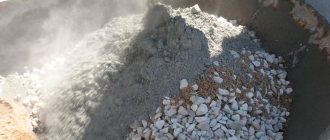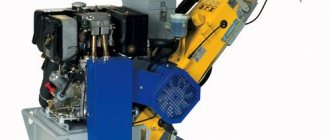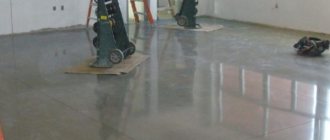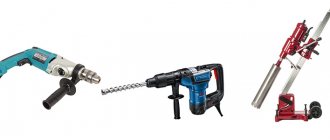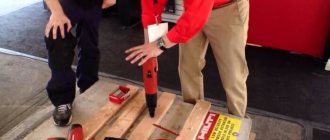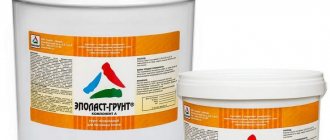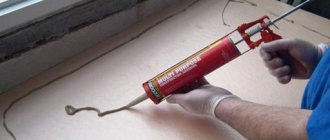Concreting the base is a rather labor-intensive process. The quality of the final result is measured not only by the strength of the coating, but also by the evenness of the surface. To ensure this, various tools are used. At the initial stage, the mixture is leveled using the rule. But after it there may be ridges left. Therefore, at the final stage of leveling, a concrete trowel is used. This is a simple, but extremely necessary tool in the work of a builder. It is quite possible to do it yourself. Before starting work, you need to understand this issue.
General characteristics of the process
The process of pouring concrete foundations is not the same for different rooms. If you need to create a floor in a large production workshop, hand tools will be practically useless. In this case, equipment with various attachments is used (rollers, discs, “skis,” etc.).
In a small room it is easier to level the level using other tools. First, wooden beacons are laid on the surface of the base. These will serve as guides for the rule. Concrete is laid between the beacons. It is carried out as a rule, distributing the mixture in an even layer along the level of the guides. This is the initial stage of pouring.
Next, a more precise smoothing of the mixture is carried out. Here you will need a concrete trowel. This is a special hand-held device that can be used both during the process of removing the mixture as a rule, and after arranging the entire base.
Chinese manufacturers value the Russian market
Chinese power trowels began to be sold in our country quite recently. What attracts buyers is primarily the price of Chinese cars. If we compare the cost of an edger from the German company Wacker Neuson and a Chinese one from Vector , then the price of the Chinese product is half as much. But the quality of trowels from China is also poor: weak engines, low-quality gearboxes, etc. are often used.
However, trowels from Masalta Engineering Co., Ltd are very popular among our builders - reasonable price, good quality, assembly with virtually no flaws, and the company provides a 1-year warranty. Today Masalta supplies Russia with a compact edger MT24-3(4) with an outer protective ring ∅610 mm and a 4.2 hp Robin engine. It is possible to install a more powerful 5.5 hp Honda engine in this model. The company's other edger, the MT30-3(4), is also powered by a 4-stroke single cylinder engine, either a 5.7 HP Robin engine or a Honda GX 160 delivering 5.5 HP. The protective ring in this model has an outer ∅760 mm.
The single-rotor model with blades or troweling disk ∅900 mm MT36-3(4) has a mass of 75 kg. The model is easily and conveniently controlled using a handle, the design of which allows it to be folded during transportation. However, the most powerful single-rotor trowels are the petrol models MT42-3/4 with a rotor diameter of 1060 mm and MT46-3/4 with a rotor diameter of 1170 mm.
Masalta offers its customers newly created electrically powered "helicopters" for indoor work. This is a mod. JM600 with a working diameter of 600 mm and a 3-phase motor with a power of 0.75 kW, as well as mod. JM900II (Dynamic) with a rotor diameter of 900 mm and a 2 kW electric motor. The Masalta designers have developed 3 models of two-rotor machines - MT836, MRT73 and MRT364, designed to perform large volumes of work on leveling concrete floors. These are self-propelled machines with non-overlapping blades; they provide a working passage width of 1860 mm with an average blade rotation speed of 140–150 rpm. Twin-rotor smoothing machines are equipped with two sets of blades for finishing the floor. The vehicles are designed to operate for up to 4 hours on a single fill-up; the gas tank capacity is 24.6 liters. The models use licensed Chinese-made Honda engines, mod. MRT73 – GX670 with 24 hp, and in mod. MT836 and MRT 364 – GX690 with 22.1 hp.
Varieties
The presented tool can be manual or have an electric or gasoline drive. For a small room, the first variety is ideal. When leveling large areas, it is better to use mechanized devices. The most commonly used are aluminum or magnesium concrete trowels. Its length is more than 1 meter. For ease of use, the profile is attached to a long handle. Because of this, the tool is somewhat reminiscent of a mop.
There is a division into channel and scraper smoothers. The first type is intended for leveling still plastic, not hardened concrete. In this case, “cement laitance” forms on the surface. It is a mixture of cement, water and sand in small quantities. The scraper type of trowels is suitable for already hardening mortar. Such tools help remove laitance from concrete.
The irons also vary in size. For a small room, small-sized equipment with a width of 13 cm and a length of 28-68 cm is suitable. The increment in size is 10 cm. The corners of the working plane should be rounded so as not to leave scratches.
Types of tools
In general, a concrete trowel is a machined meter-long strip of aluminum alloy metal to which one or two long handles are attached.
Structurally, the tool resembles a large mop for cleaning surfaces. There are two types of smoothers: classic and scraper. Classic trowels are used to smooth a still plastic surface, which allows you to effectively level the surface.
Scraper trowels are used to level the already setting material and at the same time effectively remove excess water.
Device and features
The manual concrete trowel has a number of features in its application. It is moved along the solidifying mixture back and forth, as well as from side to side. To preserve the original layer of concrete, it is necessary to move the tool in directions perpendicular to each other. Otherwise, depressions and bumps will appear. The trowel must not be immersed in concrete. It just skims the surface.
During movement, the angle of inclination of its profile surface changes. If you push the iron away from you, the far edge will rise, and vice versa. The gearbox is responsible for this movement. The plasticity of the mixture also affects the lift angle. It can reach almost 60 degrees. The tool handle can be from 3 to 12 m long. Working planes must have deflection stabilizers. The working width ranges from 1 to 5 meters. The gearbox has the shape of a cable. It connects the blade and the handle.
DIY tool
In private construction or repair conditions, a homemade tool is quite suitable. Do-it-yourself concrete trowel is quite simple. If you are not going to use it more than 1-2 times, you should not spend money on buying new equipment.
If you have a little free time, and also have the ability to handle wood, creating a trowel with your own hands and leveling the concrete with it will not be difficult. To do this, you will need to prepare wooden slats, boards, hand tools and fasteners. Usually all the necessary tools for such work are in the arsenal of a home craftsman. If they are not there, tools and materials can always be obtained. For ease of work, it is better to give preference to soft wood species. Most often, such a tool is made from such materials.
Features of operation
The correct use of the smoother is as follows:
- A concrete trowel is used only after using vibration equipment, which makes the mixture homogeneous.
- The tool is driven only along the surface of the concrete, without falling into it.
- If the mixture has greater mobility, adhesion occurs between the mechanism and the concrete. If the concrete mixture contains silica, the adhesion is enhanced. This must be taken into account when adjusting the pressure on the surface. Too much grip can change its height.
- First, the tool is directed away from you, then in the opposite direction. This goes over the entire surface. Next, they change the direction to perpendicular, and move at right angles to the area already covered. Repeat the movements back and forth. If, after passing through the floor, unevenness is observed, the operation will have to be repeated.
- When performing movements, it is advisable to imitate weak vibration, then the mixture will level out faster. Vibration is achieved by lightly shaking the instrument.
After leveling the concrete, the trowel is cleaned and left in a dry place until next use. In any case, a homemade tool will not last long, since the board will certainly warp from storage. If the device is used soon after completion of work, it can be stored. If the tool is no longer needed, it is better to simply throw it away.
It is important to remember that after using the trowel, other mandatory work is carried out: moistening the concrete, fixing it by standing and filling it with a self-leveling mixture.
Making a smoothing iron with your own hands from scrap materials is not difficult. The tool will allow you to level the concrete floor without major costs. You can work without assistants. The quality of the floor is not inferior to mechanical leveling.
This is a step-by-step guide on how to pour and level concrete. To do this, you need several tools that you can buy or make yourself. Generally speaking, there are many finishes you can choose to pour on your concrete slab or foundation. But the easiest one is to use a large formwork made from 2x4 boards.
Make sure you finish pouring your concrete slab or foundation as soon as possible. Otherwise the concrete may dry out. And you won’t have time to smooth its surface. Finishing a large concrete base is quite a complex project. To do this, it makes sense to recruit a few friends to help you and use multiple methods to get the job done right.
Working surface manufacturing technique
When wondering how to make a concrete trowel with your own hands, you should consider the advice of experienced builders. When preparing beams made of soft wood, it is necessary to pay attention to their processing.
The side of the trowel that will come into contact with the concrete must be perfectly smooth. It is pre-polished. Then the working surface is treated with a special moisture-repellent solution. This will save the tool until the end of processing the concrete base. The smoothness of sliding will be as easy as possible. The standard dimensions of the timber for the working surface are selected depending on the area of the room. The width of this product should be about 30 cm, and the length can be from 1 to 2 m.
Instructions for making from scrap materials
A homemade concrete trowel can be made quite simply.
Tools and materials:
- Board for surfaces up to 30 cm wide.
- Beam with a cross section of up to 50 mm for the handle.
- Small cross-section bars for fastening to a work surface.
- Saw or jigsaw.
- Plane.
- Medium grit sandpaper.
- Screws for fastening parts.
- Screwdriver or screwdriver.
- Moisture-resistant impregnation or drying oil.
Manufacturing and assembly nuances:
- The working surface is made of boards. The board can be from 1 to 2 meters long depending on the area of repair. The thickness of the board should not exceed 30 mm. Otherwise the tool will be too heavy. The edges of the board must be rounded with a plane or jigsaw. The surface that will come into contact with the concrete should be sanded smooth with sandpaper, as well as the edges of the product. There should be no rough spots left. After grinding, you need to use a moisture-resistant impregnation that will not allow the trowel to absorb moisture from the still wet concrete. Apply the impregnation according to the instructions and allow it to dry completely.
Instead of impregnation, you can use ordinary drying oil, which is used to carefully treat the wood. It should be taken into account that drying oil takes longer to dry than factory impregnation.
- The beam for the handle needs to be up to 6 meters long, otherwise it will be impossible for them to work alone. The edges of the timber are rounded with a plane. All irregularities and burrs are removed with sanding paper. If the room is small, you can take an old mop or shovel handle. This handle already has a round shape and is comfortable to grip. The handle should be wooden; an iron or plastic handle will not work, as it will be difficult to attach the work board to it.
- The handle is attached to the work surface at an angle of 60 degrees.
- The handle fastening consists of three bars or slats. They are attached to the handle and board with screws. The fastening connection must be made in the form of a spacer. The screws should not protrude onto the work surface so as not to disturb its smoothness. The length of the screw is selected based on the thickness of the board.
- If you have a swivel joint at hand, you can use it to attach the handle, then the product will be more maneuverable. The handle should also be attached to the hinge at an angle so that it does not dangle, but can only move.
- After assembly, the product is tested for structural strength. Place the smoother on any surface and try to move it. Check its smoothness by touch again.
- If necessary, go over the smoother again with sandpaper, eliminating any residual nicks. The smoothness should tend to mirror-like. This is difficult to achieve on wood, but getting close to absolute smoothness is quite possible.
- The finished product can be used to level concrete at home or in the country.
Making a pen
The handle is an integral element of such a product as a concrete trowel. The telescopic handle is used in purchased tools. But for homemade varieties you will just have to make a long rail. For infrequent or one-time use, this will be quite enough. The handle should be selected according to the length of the room. Typically, this element of the trowel is from 3 to 5 m. This option is even suitable for smoothing mortar along the upper cut of beacons or between brickwork.
Using a triangular spacer made of wooden slats, the handle is rigidly attached to the work area. If the grip of the working surface is large, it is difficult to guide the tool with one handle. Therefore, for the convenience of work, it is better in such cases to make two holders at once.
Metal model – assistant for a painter
It is impossible not to note another very promising model of this tool: the metal smoother has firmly occupied a niche in finishing work. Today, most professional painters use such a hand tool to apply putty to walls and then level them. Of course, there are spatulas for these purposes, but due to the fact that the working area of the trowel is metal and, as a rule, smooth, such a tool is almost no different from a spatula during work.
In some cases, it shows itself even better than a spatula, for example, when working with putty on the ceiling, such a spatula greatly facilitates the process and reduces material consumption. The principle of applying putty with our ironing tool is quite simple: apply the mixture along the entire length to the working surface and then stretch it evenly over the surface of the ceiling, while smoothing the material .
Usually, after such work, all that remains is to apply a thin finishing layer of finishing material, and the ceiling is ready for commissioning. Of course, in order to perform such work, a certain qualification is required, which comes with experience. Very often, painters joke about newbies: “In order to get a smooth surface, you need a ball-shaped trowel!” If you ever hear such an expression, know that there is no such tool in construction, it is used in medicine, it’s just a harmless joke.
Scraper smoother
A homemade concrete trowel most often involves leveling concrete that has not yet hardened. There are special attachments on sale that are used to make a scraper tool from a channel tool. Although most often they are simply included in the set of purchased ironing irons.
It is most likely impossible to make scraper work surfaces yourself. But if necessary, you can buy them. This tool will allow you to remove excess from the concrete surface. The blade is made of durable aluminum alloys. This will eliminate bumps and irregularities and fill in the depressions on the surface of the base. This tool helps to completely level the surface.
How to make a concrete floor smooth - homemade tools
Working with such a tool gives the following effects: in addition to uniformly distributing the concrete mortar, the trowels expel liquid cement that has separated from the mixture (the so-called cement laitance) and push the high-quality mortar into the voids. When working in the private sector, expensive industrial machines for smoothing concrete surfaces are not needed, so craftsmen make the devices with their own hands, and the resulting smooth floor is of the same quality as with mechanized processing.
The simplest device can be made from a wooden strip or a regular construction rule - it is attached to a long handle, and the wide and smooth surface of the tool serves as a leveling device. The name of the instrument is an interpretation of the word “correctly”, that is, evenly and smoothly. The general structure of the rule: this is a narrow and even wooden or metal ruler, which is used to quickly level large areas of mortar.
Ironing board from the rule
The rule for concrete is also used for plastering and leveling tiles and ceilings. But it is most convenient to work with the rule when leveling a concrete floor surface - the lath can be taken of such a width that it covers the entire working surface. Thus, it is enough to stretch the trowel over the concrete once so that the surface becomes even and smooth, without seams or air bubbles.
Industrial hand trowels are produced with a length of 1-3 meters with a gradation of length of 0.5 m, and a blade width of 8-10 cm. The thickness of the metal (usually duralumin - to make the structure lighter) is 0.8-1.1 mm. A homemade trowel for concrete made from wood is practically a disposable tool, since after getting wet in the solution, the wood will definitely warp when it dries, and you won’t be able to use such a trowel again. True, there is a not ideal, but quite reliable way to increase the service life of a wooden smoothing iron - soak it with drying oil and paint it. But this is also not for long, although you can probably work with such a tool 10-15 times.
But a responsible craftsman will always pay attention to a metal smoother, or make it with his own hands - from a rule or a suitable metal plate (slat). Duralumin is not only a light metal - it also does not rust, which is why duralumin rules are so popular among builders. Industrial manual devices for leveling concrete can be equipped with low stiffening ribs along the entire length of the internal working surface. To constantly monitor the horizontal level of the liquid concrete leveling process, a building level is often attached to the trowel.
Homemade wooden device
For the novice builder: To get a smooth concrete surface when working with a trowel alone, you need its width to be no more than 1.5 meters. Smoothing concrete with a wider tool requires two workers, and this operation requires some experience.
You can make a wooden rule in 30 minutes - take a planed wooden beam, attach it to a shovel holder or rake, reinforce the fastening with diagonal slats, and the trowel is ready. You can level the working surface of the timber experimentally - by running a wooden tool over dry sand or other bulk material, and marking those places where unevenness remains. The timber is leveled by planing or jointing. To lighten the overall weight of the structure, holes Ø 30-40 mm can be drilled in the timber in increments of 70-90 cm, after which the surface can be sanded with fine sandpaper.
But it’s easier and simpler to work with duralumin smoothers (industrial or homemade). And if two people work, then the length of the handle can be increased to 12 meters, that is, almost any area can be ironed without seams or bubbles. The width of the working surface of the metal strip for such tools can reach 3-4 meters. These devices are conventionally divided into the following types:
- A metal channel trowel, with which you can smooth out concrete even some time after it has been poured, but even before it sets;
- A scraper device can also level an already hardening concrete mixture, but at the same time as leveling, the scraper pulls out excess water from the surface of the concrete and excess cement laitance.
Channel smoother
When making a tool yourself, you need to follow two rules - the working smoothing surface must be flat and smooth, and the handle of the device must be such a length that you can smooth out all the corners and areas of the room.
Expert reviews
To create the finishing coating, craftsmen recommend using a scraper. A self-made concrete trowel is not used in this case. Purchased types of tools are still preferable in this case.
Since such products are made from an extrusive alloy, they are very light and maneuverable, unlike homemade ones. At the same time, such tools are characterized by high strength. The entire design facilitates a smooth change in the angle of inclination of the surface during operation.
According to expert reviews, purchased ironing irons have only one drawback - they are quite expensive. In addition, it is better to purchase such irons from good, trusted manufacturers. Cheap products are not worth the investment. Therefore, for infrequent use, it is better to make a homemade design. Especially if you plan to use it no more than two or three times.
How to use the iron
A properly made concrete trowel allows you to level fairly large areas. Thanks to the wide working surface, large areas can be processed quickly. Even with a homemade trowel you can efficiently smooth out the bumps and depressions.
Homemade varieties of tools should be used only for rooms no longer than 6 m. Otherwise, you will have to use purchased varieties. They have a telescopic handle that can reach 12 m.
After the first leveling, “cement laitance” may appear on the surface of the concrete. It should be removed with a scraper with a special blade. If during the surface treatment process it is planned to process it with various grinding machines, this stage must be carried out. Large humps and depressions must be removed before the cement hardens.
Having considered a tool such as a concrete trowel, you can correctly use it during construction or repair. In certain conditions, it is more advisable to use homemade varieties. You can easily make them yourself. But for large rooms it is better to use a purchased tool. It most often has a telescopic handle. Also, these smoothers have a set of special blades. But for infrequent use, it is recommended to make your own trowel, which will allow you to level the surface almost perfectly.
What rules should you follow to get a smooth concrete surface?
For many people, getting a smooth concrete slab is very important. The untreated coating has a huge number of shortcomings, which makes it difficult to use. During use, the surface of the concrete begins to become dusty, which is explained by the extraction of small particles of sand and cement. Such a surface has high porosity. Therefore, any spilled liquid is instantly absorbed.
This is why untreated concrete flooring is not used in residential areas as a finishing surface. Most often it is used in the form of a screed. In the future, it serves as the basis for laying the finishing decorative coating. But this technology is not suitable for installing heated floors. In this case, the finishing decorative layer will only hinder the spread of heat.
Smooth concrete floor
How to make a concrete surface ideally smooth?
Making concrete smooth is quite simple if you follow these rules:
How to level a concrete floor with your own hands
- to obtain a smooth surface, beacons, a rule and a trowel are used;
- beacons play the role of guiding elements. Concrete solution is distributed between them;
- The rule is a long narrow ruler. With its help, the solution is distributed between the beacons;
- a smoothing iron is a tool with a perfectly smooth surface. It smooths out all the bulges on the fresh concrete surface;
- To obtain an even more even surface, special ironing units are used;
- After the initial processing of concrete, it is left for a day to set. If irregularities are identified, they are removed with a wide spatula;
- a few hours after pouring, the coating is treated with bulk cement using trowels;
- at more critical facilities, the concrete surface is treated with liquid glass;
- using fluorosilicate, the concrete coating can become mirror-like;
- To give concrete increased smoothness, it is processed using grinding machines with diamond-coated discs.

